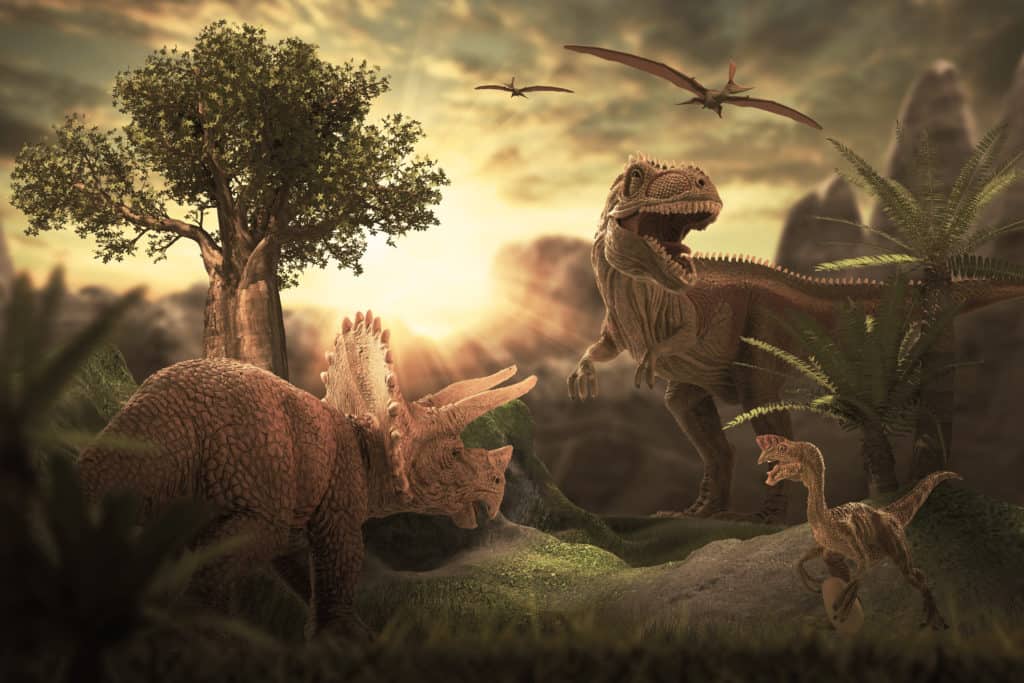A History of Destructive Pests –
Part 1
A History of Destructive Pests –
Part 1
A Constant Earthly Annoyance
Pests have been pestering since… well, the beginning of time on Earth. There is plenty of data throughout history cataloging the problems pests caused and the massive innovations we have taken to avoid them, as well as significant evidence that pests bugged humans and non-humans alike in prehistoric times as well.
This Blog Series covers these historical effects of pests. In this entry, we cover: the relationship between pests and dinosaurs, and the effects of pests on the spread of the Black Plague.

Could Pests have Ended Dinosaurs
The percentage of oxygen in our atmosphere today is roughly 21%. This was not the case in the past, however. Geologists conducted a study in which it was discovered that in the late Paleozoic Era, the percentage of oxygen in the atmosphere rose to at least 32% oxygen. Insects breathe using a series of holes along the length of their bodies that take oxygen into tubes called tracheoles. These tracheoles diffuse the oxygen on a cellular level throughout the insect. With more oxygen available, entomologists at Arizona State University suggest that insects may have really thrived in this atmosphere.
One such insect that thrived so many years ago was the infamous mosquito. Much like in Michael Crichton’s fictional story, Jurassic Park, prehistoric mosquitos have actually been discovered preserved in substances such as amber, the oldest dating back to roughly over 45 million years ago. Entomologist spouses Roberta and George Poinar collected and examined these very kinds of amber drops. Following extensive testing, they were able to extract preserved contents within the gut of two of the amber-preserved insects, which revealed some shocking details about the potential health of dinosaurs.
The first insect they analyzed contained a parasitic disease known as leishmania, which is known for infecting reptiles and is typically found in tropical regions. Depending on the severity of the disease, it can cause topical skin lesions or spread throughout attacking several internal organs. The second specimen contained pathogens that cause malaria – arguably the most infamous mosquito-borne disease today – which can be deadly. In addition to the amber-preserved insects, the Poinars analyzed various samples of fossilized dinosaur feces, which revealed further evidence of insect-transmitted parasites as well as confirmation of the presence of dysentery.
Based on these findings, the Poinars theorize that insect-transmitted pathogens could have actually been the leading catalysts for the eventual extinction of dinosaurs… which actually makes quite a bit of sense since we are still battling pests and their deadly health risks today.

The Black Plague
One of the most infamous cases of pests leaving behind a hefty death toll was the spread of the bacterium Yersinia Pestis, aka The Black Plague, throughout Europe. Originally, the highly deadly disease entered the ring in the early Middle Ages between 541 to 767, before resurfacing in the 14th Century with a death toll of over 50 million. During the time, it was believed that the disease was caused by miasma, or “bad/poisonous airs” resulting from particularly foul smells. It wasn’t until centuries later that another cause of the rapid spread of the plague was proposed: pests.
Initially, the theory was that rats alone were carrying and passing the disease themselves through bites, contact with their excrements, and simply living in close quarters with humans. As consideration of this theory progressed, it was discovered that the fleas on rats were most likely the true culprits of the historical pandemic. While the plague is mainly perceived as a historical illness infamous for killing millions of people, it is unfortunately still in existence today. Thankfully, our modern medicine can now treat the bacteria if caught early enough, however it is still wise to be very wary of fleas and wild rats.

Citations
Audoin-Rouzeau, F. (1999) [The Black Rat (Rattus rattus) and the Plague in Ancient and Medieval Western Europe], PubMed.gov. U.S. National Library of Medicine – The National Center for Biotechnology Information. Available at: https://pubmed.ncbi.nlm.nih.gov/11000955/ (Accessed: February 4, 2021).
Health Hazards Posed by Rodents (2014) Pest World. National Pest Management Association. Available at: https://www.pestworld.org/news-hub/pest-health-hub/health-hazards-posed-by-rodents/ (Accessed: June 2020).
Hughes, V. (2008) Did the Dinosaurs Bug Out?, The Smithsonian Magazine. The Smithsonian Institute. Available at: https://www.smithsonianmag.com/science-nature/did-the-dinosaurs-bug-out-180940839/ (Accessed: October 2020).
Painter, D. (N/A) Big Big Bugs, Arizona State University. Available at:https://askabiologist.asu.edu/explore/prehistoric-insects (Accessed: May 2020).
Plague (2020) Centers for Disease Control and Prevention. The National Center for Emerging and Zoonotic Infectious Diseases and The Division of Vector-Borne Diseases. Available at: https://www.cdc.gov/plague/index.html (Accessed: January 27, 2021).
Plague (no date) World Health Organization. World Health Organization. Available at: https://www.who.int/health-topics/plague#tab=tab_1 (Accessed: February 4, 2021).
Poinar, R. and Poinar, G. (2008) What Bugged the Dinosaurs? – Insects Disease, and Death in the Cretaceous. Princeton University Press.
Prevention and Control: Fleas (N/A) Illinois Department of Public Health. The Division of Environmental Health. Available at: https://www.idph.state.il.us/envhealth/pcfleas.htm (Accessed: May 2020).
Rodents (2010) Centers for Disease Control and Prevention. The National Center for Emerging and Zoonotic Infectious Diseases and the Division of High-COnsequence Pathogens and Pathology. Available at: https://www.cdc.gov/rodents/index.html (Accessed: January 27, 2021).
Why Aren’t There Giant Insects? (2012) SciShow. Available at: https://www.youtube.com/watch?v=179FuGuk1qE&list=PLB3FCEEAC84884760&index=50 (Accessed: May 2020).
Why Do We See So Many Pests in the Fall?
Why Do We See So Many Pests in the Fall? Why Do We See So Many Pests in the Fall? Summary: Fall’s cooler [...]
Why German Cockroaches are Such Problem Pests (And How to Get Rid of Them)
Why German Cockroaches are Such Problem Pests (And How to Get Rid of Them) Why German Cockroaches are Such Problem Pests (And How to Get [...]
Summer is Ending, But Pests are Still Going Strong
Summer is Ending, But Pests are Still Going Strong Summer is Ending, But Pests are Still Going Strong Summary: Summer is coming to [...]
10 Tips for Going Back to School Pest-Free
10 Tips for Going Back to School Pest-Free 10 Tips for Going Back to School Pest-Free Summary: The school year is a busy [...]
What is Bug Spray, Really?
What is Bug Spray, Really? What is Bug Spray, Really? Summary: Bug spray is a great tool for preventing pests during outdoor activities, [...]
The Various Personalities of Stinging Pests
The Various Personalities of 5 Stinging Pests The Various Personalities of 5 Stinging Pests Summary: Stinging insects are among the most common summer [...]

